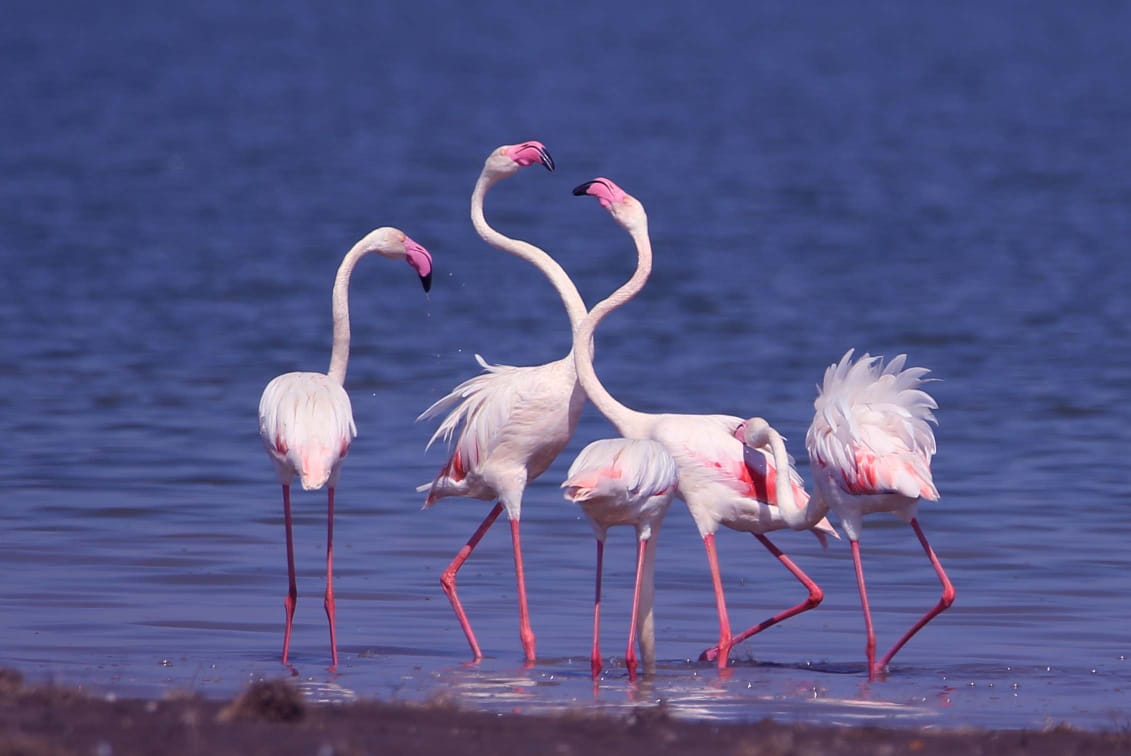The backwaters attract hundreds of migratory bird species annually. Efforts are also being made to get the 'Ramsar site' tag.

Flamingoes are the most attractive and sought after bird in the backwaters of Almatti Dam. (Pic - Raju Davalagi)
In a major boost to wildlife conservation, Karnataka’s Basavaraj Bommai-led Cabinet has given the nod to declare the backwaters of the Lal Bahadur Shastri Water Reservoir (Almatti Dam) a bird sanctuary.
Wildlife wardens, birdwatchers, and wildlife photographers are brimming with joy as the state government is working on issuing a gazette notification to declare over 12,350 hectares of land rich in flora and fauna — spread over 75 kilometres — as a “wildlife protected area” in and around the Chikka Sangama village in the Bagalkot district of the state.
The project was initially announced by Mahadevapura MLA Aravind Limbavali, who was the forest minister in the BS Yediyurappa-led government in 2021.
Within a month of announcing the project, the then-chief minister gave his nod for developing a bird sanctuary at Chikka Sangama during a meeting with the members of the Karnataka State Wildlife Board (KSWB) in January 2021.
The state government approved the declaration of the backwaters of Almatti Dam as a bird sanctuary in a recently-held Cabinet meeting under the headship of Chief Minister Bommai, who also holds the forest portfolio. With this, Karnataka is all set to have its 13th bird sanctuary.
“The ornithologists and wildlife experts associated with top environment conservation institutions have carried out a detailed geographical and bird survey in the backwaters of Almatti Dam. The report has been submitted to the state government,” stated Prashanth Shankinmath, deputy conservator of forest (DCF) of Bagalkot.
Shankinmath added, “The Cabinet has given the nod to go ahead with the project. However, it will be valid only after the gazette notification is issued. The drafting work of the gazette is underway. The notification of the Chikka Sangama Bird Sanctuary will be issued in a week or two.”
He also said: “Along with the conservation of the rich wildlife in the backwaters, an effort is also being made to develop these areas as ecotourism hotspots. We have already identified the places for ecotourism and conservation. The work will be carried out once the funds are sanctioned exclusively for the project.”
The Chikka Sangama village, which is 36.4 km away from the district headquarters, is located in the Bilagi taluka.
This village is on the confluence of the rivers Krishna and Ghataprabha, and hosts hundreds of species of migratory birds.
Annually, across seasons, around 200 different species of migratory birds arrive at the backwaters of Almatti Dam from not just Asia but also Europe, Africa, the Americas, and Australia.
“River tern, spoonbill, flamingo, pintail duck, bar-headed geese, Asian openbill, black-winged stilt, red-wattled lapwing, and many different species of birds have been identified in this region. Flamingoes are the most attractive and sought-after birds in the region,” said senior wildlife warden MR Desai.
“The migratory birds come in huge numbers as the place is ideal for nesting and breeding. Moreover, there are over 100 ‘natural islands’ in the backwaters. This is the ideal place for the habitat of migratory birds,” said Desai, pointing out the importance of natural islands in the backwaters of Almatti.
The region’s wildlife conservationists have worked tirelessly to convince the state government to announce the backwaters of Almatti Dam as a wildlife-protected area.
“We are appealing to the state government to declare around 75 km (Almatti to Kolhar) of the backwaters of Almatti Dam as a wetland. It will give conservation efforts a big boost and also tackle the human-animal conflict in the region,” Desai stressed.
The forest officials are already working on gathering the necessary documents and geographical evidence to get the Ramsar Convention tag, while the state government is yet to officially declare the bird sanctuary at Chikka Sangama.
The Ramsar Convention is an intergovernmental treaty that provides the framework for the conservation and wise use of wetlands and their sources. The Ramsar Convention is headquartered in Gland, Switzerland.
“The senior ornithologists associated with the government have carried out a bird survey and documentation of the backwaters of Almatti Dam. The same will be submitted to the government and authorities concerned to get the tag of Ramsar site,” Bagalkot DCF Shankinmath confirmed.
“Experts have identified over 200 species of birds, where 170 of them have been photographed. Senior experts have carried out a study on the wetlands located in the backwaters of Almatti Dam,” Desai told South First.
He reiterated, “The main aim of a Ramsar site is to develop and maintain an international network of wetlands for the preservation of biological diversity and for sustaining human life. A Ramsar site will give a big boost for the conservation of wetlands in the region.”

Apr 19, 2024

Apr 19, 2024

Apr 19, 2024

Apr 19, 2024

Apr 19, 2024